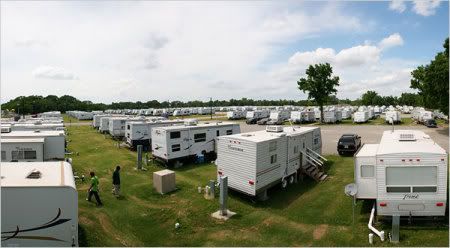Gulf Watch: Trailer troubles mount as FEMA tarries with tests
 The federal government has known there were toxic levels of formaldehyde in temporary trailers provided to people displaced by Hurricane Katrina at least as far back as April 2006. That's when the Sierra Club released the results of tests it conducted on Federal Emergency Management Agency trailers in Mississippi showing that the cancer-causing chemical was present at dangerously elevated concentrations. The group also found similar problems in tests of FEMA trailers in Louisiana and Alabama.
The federal government has known there were toxic levels of formaldehyde in temporary trailers provided to people displaced by Hurricane Katrina at least as far back as April 2006. That's when the Sierra Club released the results of tests it conducted on Federal Emergency Management Agency trailers in Mississippi showing that the cancer-causing chemical was present at dangerously elevated concentrations. The group also found similar problems in tests of FEMA trailers in Louisiana and Alabama.
Following heated congressional hearings in July, FEMA leaders said that they would work with the federal Centers for Disease Control and Prevention to conduct their own tests of trailer air quality. But it wasn't until yesterday that the agencies announced they would begin air sampling in 500 trailers starting next Friday, Dec. 21. The testing is expected to take about five weeks, with the findings to be released some time in early 2008.
In a posting to the Toxic Trailers website, Becky Gillette of the Mississippi Sierra Club says that at this point in time more tests are not the answer:
Instead of another round of testing, FEMA needs to immediately purchase some formaldehyde free emergency housing. That type of housing is available. Since the problem has already been well established, why is FEMA being so slow to act to replenish the stock of housing needed for emergencies from manufacturers willing to use building materials that don't make people sick?
Another issue is remediation. With FEMA having purchased more than $1 billion worth of these campers, it should be joining with the CDC to evaluate various remediation tools for reducing formaldehyde to safe levels.
Gillette also raises concerns about why FEMA -- after having promised it would undertake tests back in July -- waited five months to get started:
...[I]t is troubling that FEMA/CDC have decided to undertake this testing at the time of year when formaldehyde emissions would be expected to be at their lowest levels. Formaldehyde outgassing increases with heat or humidity, so it seems no "accident" that FEMA -- which promise[d] last summer to quickly begin a testing program -- has delayed and delayed until the coldest weather of the year.
While FEMA is just beginning to get a handle on a serious problem brought to its attention more than a year and a half ago, new problems with Katrina trailers are coming to light that also demand the agency's action.
In the Institute's August 2007 report titled "Blueprint for Gulf Renewal: The Katrina Crisis and a Community Agenda for Action," [PDF] Sharon Hanshaw, executive director of Mississippi's Coastal Women for Change, described how many of FEMA trailers have become infested with mold, compounding formaldehyde-related health problems and forcing cash-strapped survivors to continuously replace ruined possessions.
Last month, KNOE-TV in Monroe, La. investigated further, documenting a design flaw in FEMA's mobile homes that could lead to a buildup of potentially toxic mold levels. It also found that FEMA had been selling the flawed homes to the public in spite of the test results. One science building expert who examined the inside walls of two FEMA homes in Ouachita Parish, La. found one type of mold spore at up to 30,000 times the levels found outside, indicating a wall exposed to excessive moisture levels.
Formaldehyde and mold are not the only threats facing FEMA trailer residents, either. Another is fire.
An investigative report in New Orleans' latest Gambit Weekly newspaper found that trailer occupants face a high risk of injury or death due to fires and explosions that occur when gas fumes from propane burners build up inside the units and are accidentally ignited. The paper found that at least five Louisianans have been killed and nine injured by such incidents since January 2006. While trailer occupants are to blame for some of the fires, other incidents were caused by improper installation and maintenance by FEMA contractors:
A recent review of video-recorded meetings of the Louisiana LP Gas Commission (LPGC) Board shows prime contractors -- engineering firms such as the Shaw Group, CH2M Hill and Fluor Inc. -- also lacked sufficient understanding of propane systems when they received FEMA contracts worth several hundred-million dollars to install tens of thousands of trailers for storm victims. Setting up the trailers improperly increases the risk of explosions and fires, and LPGC regulations explicitly recognize this. ...
...It was before this board that the major three contractors for FEMA trailer installation and maintenance in Louisiana had to answer allegations they did not have the proper certification or permits to work on propane systems when they undertook no-bid, "price plus fixed-fee" federal contracts to provide housing for hurricane victims. Board records indicate none of the three had even applied for such certifications or permits until half a year later, after they were cited by LPGC inspectors. By that time, at least 80,000 trailers had already been installed. The violations were discovered after LPGC inspectors looked into the companies' operations in response to news reports about a surge in trailer explosions in the state.
One LPGC inspector told Gambit that working with the government contractors was "like dealing with used car salesmen on the seedy side of town." Are these really the kind of operators to whom taxpayers should be handing millions of dollars in no-bid contracts?
Tags
Sue Sturgis
Sue is the former editorial director of Facing South and the Institute for Southern Studies.
